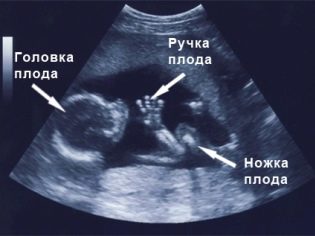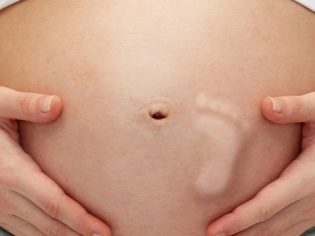No movement at the 17-20 weeks of pregnancy
With complaints about the lack of movement at the 17-20 week of pregnancy, women are treated quite often. Whether this is considered a deviation and what the future mother will do, we will tell in this article.
Why the fruit does not move?
The formulation of this question is incorrect initially. The fact is that the fetus moves and does so with enviable regularity, just for some reason, the mother simply does not feel his movement. The reasons can be very diverse. If we talk about the period from 17 weeks of gestation to 20 weeks inclusive, the reason for this is one - the size of the fetus is too small.
Kids begin to move in the 8th week of pregnancy. The movements of the arms, legs, and even the pushes and turns of the crumbs in the womb cannot be perceived by the pregnant woman, because the weight of the fetus is no more than a gram. Only when the impact of the baby on the wall of the uterus is greater than the threshold of perception of the nerve receptors, a woman will begin to feel the movement of her baby. For this little one needs to grow.
What is considered the norm?
In obstetrics, it is considered perfectly normal if a woman who is 17, 18 or 19 weeks pregnant, does not feel perturbations. And in the 20th week and even later, distinct sensations may not be observed. The norms, which, by the way, are rather averaged, say that a woman can begin to feel the first movements of babies in the womb during the period from 16 to 22 weeks of pregnancy. It is during this period that the long awaited moment usually comes. And because a woman who turns to the doctor with complaints that the baby does not move in the period from 17 to 20 week, just advise to wait a bit.
Norms exist only in textbooks and medical literature. In practice, they can be quite different in one way or the other.
What affects the movement of the baby?
Women who at 18 or 19 weeks do not feel the movements of the baby, usually begin to worry. Their condition is “warmed up” by reviews of other future mothers, who write on the Internet, that they have long since felt their movements in their 18-19 weeks. The advice here is only one - do not look back at others and do not panic. Let's calmly see why different women who are on the same term can feel or not feel the movement of babies. So, the reason for the lack of sensations may lie in the following:
Pregnancy - the first
In this case, the woman simply does not know what the first shocks of the child really should be. When there is no experience of experiencing such sensations, it is quite difficult to notice them for the first time. They are perfectly "masked" by the fermentation of gases in the intestines. Sometimes a woman does not even realize that she already feels the movements, simply does not identify them as such. Often these sensations are described as a light, delicate touch from the inside (feather, fish, butterflies). But no verbal descriptions can convey all the nuances of this sensation.
During the second, third or subsequent pregnancy, the woman already distinguishes perturbations from gas and rumbling in the stomach. Therefore, it begins to feel them earlier - at 16-17 weeks, and sometimes earlier - at 14-15 weeks. Experience is the best id.However, it is not only the experience of experiencing perturbations earlier. With repeated pregnancy, the walls of the uterus are more elastic, stretched, so the babies are able to “reach out” to their mother faster.
Build and physique
The walls of the uterus themselves do not have sensitivity. The signal to the woman’s brain about the movement inside sends the nerve endings to the peritoneum. It is clear that with a decent layer of subcutaneous fat, receptors will receive the coveted signal much later. That is why women with obesity or overweight feel perturbations later than thin, slender pregnant women.
Plays the role and size of the pelvis. In women with a narrow pelvis, the sensations of fetal movements are manifested earlier than in women with a wide pelvis.
Activity and daily routine
If a woman stays at home and enjoys her “interesting position”, she has more chances to feel a stir before a woman who moves a lot, works, attends classes at the university, etc. The more active a future mother leads, the more difficult her during the day to listen to her feelings.
But in the evenings, when the pregnant woman finally takes a horizontal position after a hard day, the baby may well have an effect. Some say that for the first time they felt their crumb at night.
Features of the location of the fetus
Of course, plays the role of crumbs in my mother's womb. If the placenta is fixed on the back wall, which happens in most cases, then the movements of the arms and legs will be directed to the side or the anterior abdominal wall, so the woman can feel it earlier.
But if the “baby seat” is located on the front wall of the female reproductive organ, then the movements of the fetal limbs will be directed toward the intestines, and to feel them, it will take more time until the baby is large enough.
Fruit temperament and other conditions
It is hard to believe, but children already at 18-20 weeks of pregnancy have a completely different temperament. Some spend most of their time in a nap, others are more active. If there is no perturbation, it is possible that a calm melancholic or phlegmatic person grows inside you, which after birth will not be too active, at least for the time being.
The weather also affects the activity of babies - on sunny days, children are more active than on rainy or snowy ones.
Experienced obstetricians recommend women to communicate with their children, more often to stroke the tummy, to contact the baby gently, to persuade him to respond to the movement of the movements. He still does not hear his mother, but he already perceives the vibrations of her voice, as "heard", for example, by reptiles. A crumb can quite distinguish a bad mother's mood from a good one.
It is useful to communicate with the baby at any time - both at the very beginning of pregnancy and on the eve of birth.
One should not think that the first stirring means the beginning of regular tangible movements. Regular movements and jolts of the baby will be only by the 28th week of pregnancy, but for the time being it is not worth worrying if the baby once made itself felt and again fell silent for a day or two. Per day, children at this gestation period make up to 300 movements, but the expectant mother can feel only a small part of them - no more than a few episodes per day, and most often 1-2 movements.
Tips and tricks
To feel the long-awaited first movements of the baby, a woman who is at 17-20 weeks of pregnancy, you need to calm down and stop nervous. When the future mother is calm, the baby develops unhindered, according to the term.
All that is required of a woman is to follow the regimen recommended by the doctor, eat fully, take vitamins, breathe fresh air. After the mother takes an oxygen cocktail or after ozone therapy, the kids usually become noticeably more active.
Already at this time, children can distinguish between the main flavors of amniotic fluid. To cause the revival of the baby, it is enough to eat a small piece of chocolate, drink a glass of warm milk before you lie down in the evening to rest.Quite often it helps to feel the movement in a relaxed state.
For information on how to count fetal movements, see the following video.



















